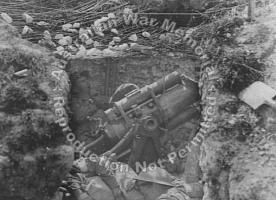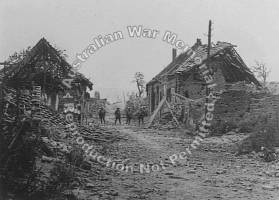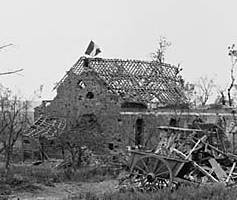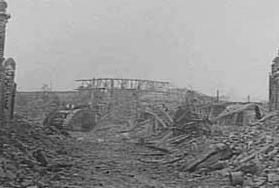
Men of the 15th Battalion, on the day of the fight at Hamel, worn out and asleep under camouflage which was found covering a German trench mortar in Pear Trench. AWME02664© |
The assault was launched at 3.10 a.m.
at the first light of dawn. Every infantryman carried 220 rounds, two Mills
bombs, an extra flask and a drum magazine for Lewis-guns. These guns were
added to the 46 heavy machine-guns and their crews involved in the action.
The Lewis-gun was lighter and handier. It only required two gunners. In
some places, clouds of smoke hid the first wave followed by tanks. Some
of the defenders became conscious of the danger once the assailants were
very close. In Vaire wood, the surprised Germans still wore their gas masks.
Vaire wood and Hamel wood quickly felt in the 4th brigade hands.
|

Australians searching for wounded amongst the ruins, the day following the capture of the village. In the event of discovering a lurking Hun (German), overlooked by the mopping up parties, the men, it will be seen, are keeping their revolvers handy. AWME02666© |
Concerning the village, the 11th brigade
was in charge of its capture. The 43rd battalion had to take the village
and eliminate there any resistance. The 44th, divided in two halves, had
to go beyond the village on each side (also see order
of battle). Six tanks would escort each of these two battalions. Immediately
west of the now burning village, the German started to resist vigorously.
The assailants were stopped and confronted the enemy by exchanging fire
and grenades. Finally, the German were attacked on the flank by an American
section commanded by an Australian lieutenant. Just north of the village
was a little wooded space named Nolamel wood. The enemy solidly hanged
it. The Australian lost their way in the smoke but their captain succeeded
into guiding them by watching the flashes of the shells striking the top
of the trees. There, the Germans realized they were turned at the moment
they started to fire. Then, the same diggers were halted by a machine-gun
on the edge of the village. It only stopped when a tank ran over it.
|

The French Tricolour, erected by Captain J. Moran of the 43rd Battalion, on one of the ruined houses, on the morning of its capture by the Australian troops, during the battle. AWME02667© |
After the barrage had move away, the
companies of the 43rd battalion entered the village by the north and the
south and also by west. The Germans were retrenched in cellars and dugout.
Le Hamel was totally mopped up near 7.00 a.m. and a French flag was hang
up by an Australian officer on the top of the eastern house of the village.
300 Germans were captured, among them a battalion commander and his staff.
Meanwhile, the 44th battalion and the 15th on south advanced towards enemy
positions, a knot of old trenches. The Australians reoccupied those positions
one named “Wolfsberg”. During, the morning, near 10.00 a.m., the Germans
tried a counter-attack with artillery support. They advanced 200 meters
but were finally pushed back.
|

